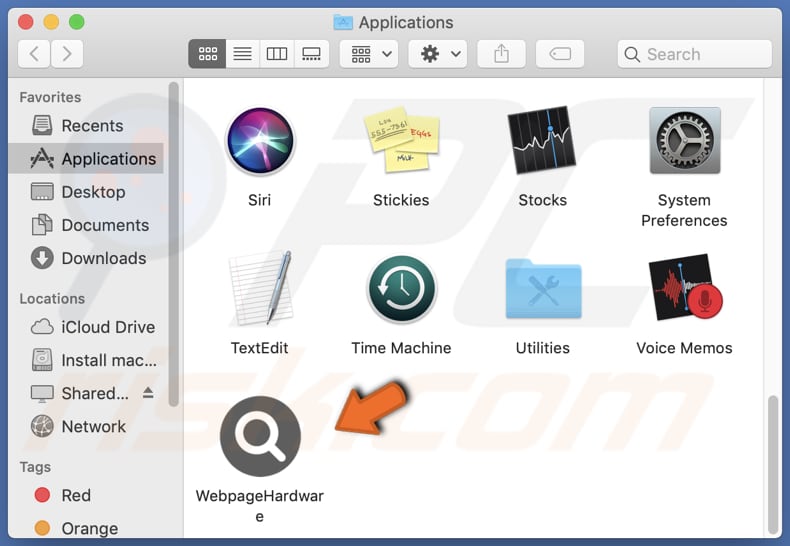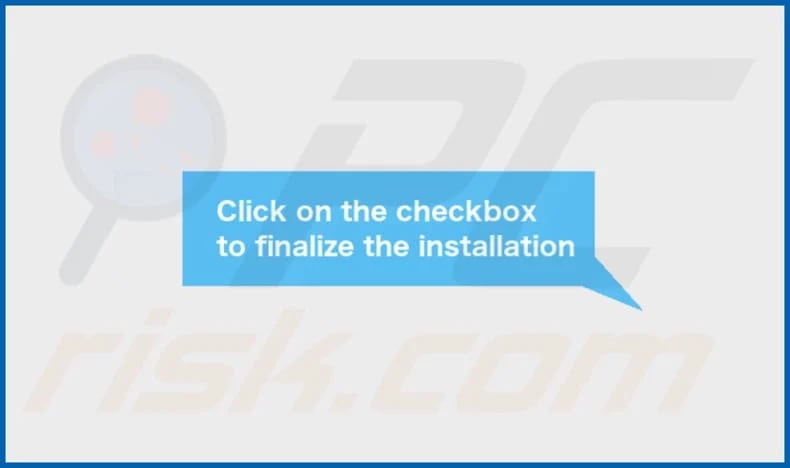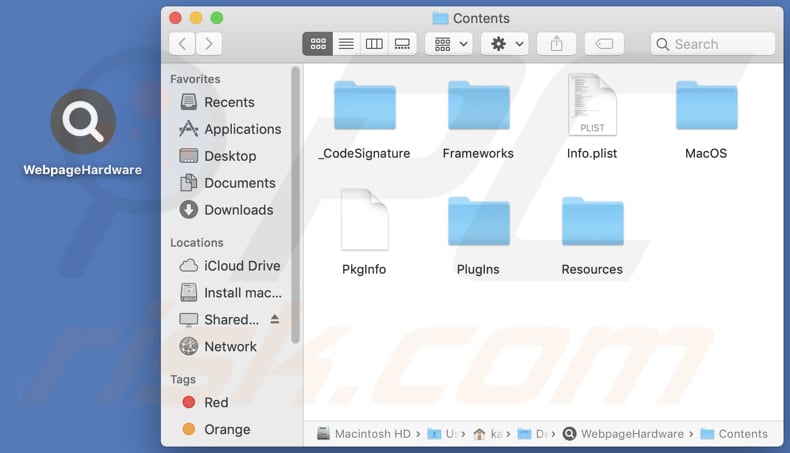Get free scan and check if your device is infected.
Remove it nowTo use full-featured product, you have to purchase a license for Combo Cleaner. Seven days free trial available. Combo Cleaner is owned and operated by RCS LT, the parent company of PCRisk.com.
What kind of application is WebpageHardware?
After evaluating the WebpageHardware application, we have determined that it displays intrusive advertisements. These types of applications are commonly referred to as adware or advertising-supported applications. It is common for users to install adware inadvertently.

WebpageHardware adware in detail
WebpageHardware can display a variety of advertisements, including pop-up ads, banner ads, in-text ads, interstitial ads, and video ads. These ads can appear on websites, within applications, or even on the desktop. The content of the ads can vary widely and may promote various products, services, websites, or offers.
Ads displayed by WebpageHardware can open websites that host malware or engage in phishing scams, attempting to trick users into revealing personal information or downloading harmful software. Also, they can open pages that offer fake products, services, or opportunities designed to deceive users and extract money or personal information from them.
Furthermore, ads originating from WebpageHardware may lead users to adult content websites or other pages with explicit material. It is important to note that these pages can pose risks to users' privacy, security, and overall browsing experience. It is recommended to avoid interacting with ads from shady adware and to take necessary precautions to protect against potential threats.
In addition to displaying unwanted and dubious ads, WebpageHardware may gather various information. This may include browsing history, search queries, IP addresses, geolocation information, and website preferences. Additionally, adware can gather personal information such as email addresses, usernames, and even financial data in some cases.
| Name | Ads by WebpageHardware |
| Threat Type | Adware, Mac malware, Mac virus |
| Detection Names | Avast (MacOS:Adload-CA [Adw]), Combo Cleaner (Gen:Variant.Adware.MAC.Adload.31), ESET-NOD32 (A Variant Of OSX/Adware.Synataeb.H), Kaspersky (Not-a-virus:HEUR:AdWare.OSX.Adload.j), Full List (VirusTotal) |
| Additional Information | This application belongs to Adload malware family. |
| Symptoms | Your Mac becomes slower than normal, you see unwanted pop-up ads, you are redirected to dubious websites. |
| Distribution methods | Deceptive pop-up ads, free software installers (bundling), torrent file downloads. |
| Damage | Internet browser tracking (potential privacy issues), display of unwanted ads, redirects to dubious websites, loss of private information. |
| Malware Removal (Windows) |
To eliminate possible malware infections, scan your computer with legitimate antivirus software. Our security researchers recommend using Combo Cleaner. Download Combo CleanerTo use full-featured product, you have to purchase a license for Combo Cleaner. 7 days free trial available. Combo Cleaner is owned and operated by RCS LT, the parent company of PCRisk.com. |
More about adware
In some cases, adware can change the default search engine and alter the homepage, and other settings of web browsers to promote fake or untrustworthy search engine. Browser hijacking can significantly disrupt the user's browsing experience and may require additional steps to restore the browser settings to their original state.
Examples of apps similar to WebpageHardware are AssistivePlatform, BalanceSignal, and DefaultOptimization.
How did WebpageHardware install on my computer?
Adware is often bundled with legitimate software downloads. When users install the desired program, they unknowingly also install the adware along with it. This method is prevalent in free software downloads, where the adware's presence is often hidden within the installation process.
Also, adware can be distributed through malicious websites that employ deceptive tactics to trick users into downloading and installing unwanted software. In other cases, adware creators may imitate legitimate software update prompts to trick users into installing adware. File-sharing networks and deceptive ads can also be used to distribute adware.
How to avoid installation of unwanted applications?
Stick to reputable websites and verified app stores to minimize the risk of adware bundled with downloads. Avoid interacting with notifications from dubious pages and ads displayed on websites of this kind. Pay close attention to the installation process of any software you download. Opt for "Custom" or "Advanced" installation options whenever available.
If your computer is already infected with WebpageHardware, we recommend running a scan with Combo Cleaner Antivirus for Windows to automatically eliminate this adware.
A message that appears once WebpageHardware is installed:

WebpageHardware's installation folder:

Instant automatic malware removal:
Manual threat removal might be a lengthy and complicated process that requires advanced IT skills. Combo Cleaner is a professional automatic malware removal tool that is recommended to get rid of malware. Download it by clicking the button below:
DOWNLOAD Combo CleanerBy downloading any software listed on this website you agree to our Privacy Policy and Terms of Use. To use full-featured product, you have to purchase a license for Combo Cleaner. 7 days free trial available. Combo Cleaner is owned and operated by RCS LT, the parent company of PCRisk.com.
Quick menu:
- What is WebpageHardware?
- STEP 1. Remove WebpageHardware related files and folders from OSX.
- STEP 2. Remove WebpageHardware ads from Safari.
- STEP 3. Remove WebpageHardware adware from Google Chrome.
- STEP 4. Remove WebpageHardware ads from Mozilla Firefox.
Video showing how to remove WebpageHardware adware using Combo Cleaner:
WebpageHardware adware removal:
Remove WebpageHardware-related potentially unwanted applications from your "Applications" folder:

Click the Finder icon. In the Finder window, select "Applications". In the applications folder, look for "MPlayerX", "NicePlayer", or other suspicious applications and drag them to the Trash. After removing the potentially unwanted application(s) that cause online ads, scan your Mac for any remaining unwanted components.
DOWNLOAD remover for malware infections
Combo Cleaner checks if your computer is infected with malware. To use full-featured product, you have to purchase a license for Combo Cleaner. 7 days free trial available. Combo Cleaner is owned and operated by RCS LT, the parent company of PCRisk.com.
Remove adware-related files and folders

Click the Finder icon, from the menu bar. Choose Go, and click Go to Folder...
 Check for adware generated files in the /Library/LaunchAgents/ folder:
Check for adware generated files in the /Library/LaunchAgents/ folder:

In the Go to Folder... bar, type: /Library/LaunchAgents/

In the "LaunchAgents" folder, look for any recently-added suspicious files and move them to the Trash. Examples of files generated by adware - "installmac.AppRemoval.plist", "myppes.download.plist", "mykotlerino.ltvbit.plist", "kuklorest.update.plist", etc. Adware commonly installs several files with the exact same string.
 Check for adware generated files in the ~/Library/Application Support/ folder:
Check for adware generated files in the ~/Library/Application Support/ folder:

In the Go to Folder... bar, type: ~/Library/Application Support/

In the "Application Support" folder, look for any recently-added suspicious folders. For example, "MplayerX" or "NicePlayer", and move these folders to the Trash.
 Check for adware generated files in the ~/Library/LaunchAgents/ folder:
Check for adware generated files in the ~/Library/LaunchAgents/ folder:

In the Go to Folder... bar, type: ~/Library/LaunchAgents/

In the "LaunchAgents" folder, look for any recently-added suspicious files and move them to the Trash. Examples of files generated by adware - "installmac.AppRemoval.plist", "myppes.download.plist", "mykotlerino.ltvbit.plist", "kuklorest.update.plist", etc. Adware commonly installs several files with the exact same string.
 Check for adware generated files in the /Library/LaunchDaemons/ folder:
Check for adware generated files in the /Library/LaunchDaemons/ folder:

In the "Go to Folder..." bar, type: /Library/LaunchDaemons/

In the "LaunchDaemons" folder, look for recently-added suspicious files. For example "com.aoudad.net-preferences.plist", "com.myppes.net-preferences.plist", "com.kuklorest.net-preferences.plist", "com.avickUpd.plist", etc., and move them to the Trash.
 Scan your Mac with Combo Cleaner:
Scan your Mac with Combo Cleaner:
If you have followed all the steps correctly, your Mac should be clean of infections. To ensure your system is not infected, run a scan with Combo Cleaner Antivirus. Download it HERE. After downloading the file, double click combocleaner.dmg installer. In the opened window, drag and drop the Combo Cleaner icon on top of the Applications icon. Now open your launchpad and click on the Combo Cleaner icon. Wait until Combo Cleaner updates its virus definition database and click the "Start Combo Scan" button.

Combo Cleaner will scan your Mac for malware infections. If the antivirus scan displays "no threats found" - this means that you can continue with the removal guide; otherwise, it's recommended to remove any found infections before continuing.

After removing files and folders generated by the adware, continue to remove rogue extensions from your Internet browsers.
Remove malicious extensions from Internet browsers
 Remove malicious Safari extensions:
Remove malicious Safari extensions:

Open the Safari browser, from the menu bar, select "Safari" and click "Preferences...".

In the preferences window, select "Extensions" and look for any recently-installed suspicious extensions. When located, click the "Uninstall" button next to it/them. Note that you can safely uninstall all extensions from your Safari browser - none are crucial for regular browser operation.
- If you continue to have problems with browser redirects and unwanted advertisements - Reset Safari.
 Remove malicious extensions from Google Chrome:
Remove malicious extensions from Google Chrome:

Click the Chrome menu icon ![]() (at the top right corner of Google Chrome), select "More Tools" and click "Extensions". Locate all recently-installed suspicious extensions, select these entries and click "Remove".
(at the top right corner of Google Chrome), select "More Tools" and click "Extensions". Locate all recently-installed suspicious extensions, select these entries and click "Remove".

- If you continue to have problems with browser redirects and unwanted advertisements - Reset Google Chrome.
 Remove malicious extensions from Mozilla Firefox:
Remove malicious extensions from Mozilla Firefox:

Click the Firefox menu ![]() (at the top right corner of the main window) and select "Add-ons and themes". Click "Extensions", in the opened window locate all recently-installed suspicious extensions, click on the three dots and then click "Remove".
(at the top right corner of the main window) and select "Add-ons and themes". Click "Extensions", in the opened window locate all recently-installed suspicious extensions, click on the three dots and then click "Remove".

- If you continue to have problems with browser redirects and unwanted advertisements - Reset Mozilla Firefox.
Frequently Asked Questions (FAQ)
What harm can adware cause?
Adware on your computer can lead to a compromised browsing experience and negatively affect your system's performance.
What does adware do?
The main objective of adware is to deliver advertisements, but it can also have the capability to hijack web browsers and collect various types of data.
How do adware developers generate revenue?
Adware developers primarily generate revenue by participating in affiliate programs, where they earn money by promoting different products, websites, or services. This allows them to profit from the advertisements displayed through the adware they distribute.
Will Combo Cleaner remove WebpageHardware adware?
Combo Cleaner can scan your computer and effectively eliminate all adware-type applications. However, it is important to know that manual removal might not always provide a complete solution, as there could be hidden residual files within the system. Even after uninstalling the software, certain components may remain present and active.
Share:

Tomas Meskauskas
Expert security researcher, professional malware analyst
I am passionate about computer security and technology. I have an experience of over 10 years working in various companies related to computer technical issue solving and Internet security. I have been working as an author and editor for pcrisk.com since 2010. Follow me on Twitter and LinkedIn to stay informed about the latest online security threats.
PCrisk security portal is brought by a company RCS LT.
Joined forces of security researchers help educate computer users about the latest online security threats. More information about the company RCS LT.
Our malware removal guides are free. However, if you want to support us you can send us a donation.
DonatePCrisk security portal is brought by a company RCS LT.
Joined forces of security researchers help educate computer users about the latest online security threats. More information about the company RCS LT.
Our malware removal guides are free. However, if you want to support us you can send us a donation.
Donate
▼ Show Discussion